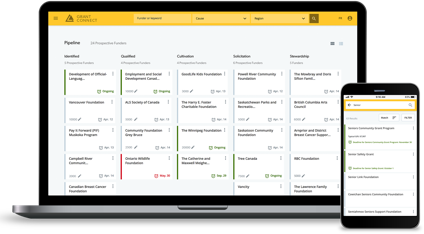I’ve always been a fundraiser and I love it, but every time I introduce myself as a fundraiser, I am met with the exact same response:
“Wow! That must be a really hard job. I could never do that.”
“It takes a certain kind of person to work in the nonprofit sector.”
Or the worst: “I have no money – sorry.” (As IF I walk around asking random people for money all the time. Ha!)
Fundraising is the “F” word of our sector – most people fall into fundraising reluctantly and some end up loving it, but for the majority of reluctant fundraisers, they stay that way – always reluctant, putting it off, finding reasons why they should focus on other things besides fundraising.
But what if we paused for a moment and thought about the underlying factor behind the hesitation to fundraise. What if we identified why fundraising makes so many people feel icky and fix it? What potential would that unlock for our missions?
Just do it?
So much fundraising advice is focused on tactics – just do this one thing. Write this way. Ask this way. Some of it seems simple – and it often is! So why do so many reluctant fundraisers have such a hard time doing simple things?
The answer is both simple and complex – our brains.
Hardwired against change
Our brain simplifies complex decisions into shortcuts or neural pathways. This allows those decisions to be made faster and with less effort, preserving your brain’s energy for more important things. These shortcuts are developed through repetition, which turns into habit. Brilliant, right? But, this means changing our habits and behaviours is hard and takes time.
And it’s even harder because those shortcuts are so ingrained, that we don’t realize our brains are distorting, or filtering, our daily experiences. These shortcuts are formed by two major influences: repetition and survival. And there are patterns to the shortcuts, often called biases or heuristics.
So how does this show up in fundraising?
Negativity Bias
One pattern that shows up consistently in our neural networks is that our brain overemphasizes negative things and underemphasizes the positive. We have a human tendency to fixate on the negative. And what you focus on is what gets amplified. Perhaps you send an email to your email list and one person responds saying, “You email me too much.” However, as a result of you sending that one email, 100 people donate. That’s a massive positive! However, your mind will tend to focus on that one negative comment, which will far outweigh the success you have. You start doubting yourself. Should I ask less often? Am I sending too many emails? Yikes, people are going to start unsubscribing. You might have just raised $1,000, but that one negative response gets amplified in your brain. Sound familiar?
Confirmation Bias
Confirmation Bias means we overemphasize information that supports our existing beliefs. Most people will say something like, “I’m not a good fundraiser,” so your brain will search for evidence to support this belief and will ignore any evidence that contradicts it. I’ve done fundraising audits for organizations that insist their fundraising is terrible, but when I look at the numbers, it’s absolutely not true. From the outside, I can clearly see their success, but because the individual has primed their brain to support that belief, it distorts the data so all they see is failure and proof of their point that they’re bad at raising funds.
Status Quo Bias
With Status Quo Bias, it is safer to do what has always been done or stick with a decision that was made previously. This happens EVEN when the cost to change is small and the importance and benefit of that change is high. I see this with organizations all the time. Choosing to continue to host a fundraising event that doesn't net any money in lieu of taking all the time and energy you put into hosting the event and instead redirecting it toward a more productive fundraising strategy. Or spending time on administrative tasks that can be easily automated because you don't like investing in technology or changing your systems and processes. Even if the technology option is WAY cheaper than the time it takes to do the work manually, you still see it as an added cost. And even if you could take that person's time and have them work on programming or fundraising or anything that contributes more directly to your mission, you still resist.
The unconscious sequence of events
All of our behaviour is governed by these shortcuts in our brains, but here is what’s happening if we uncover the sequence of those shortcuts:
Circumstances → beliefs → feelings → actions → results
Here’s an example of a sequence I see come up again and again. I always recommend that individuals book meetings with their donors and supporters (individuals, corporations, foundations) to get to know them and find out why they support your organization. There is no ask in these meetings – it’s just a chance to listen and learn. It doesn’t matter how many times I repeat this advice, most reluctant fundraisers never get started. They never send that email or pick up the phone. Here’s what that sequence might look like:
Circumstance: You learn that without a doubt, one of the most effective actions you can take with fundraising (especially mission-centered fundraising) is to get to know your supporters.
Belief: Your brain is slamming on the breaks. I believe that I’m not experienced enough or don’t know the “right” way to manage these meetings. I believe I can’t be authentic, and I have to present myself in a way that is uncomfortable or not “me.”
Feelings: I feel nervous and anxious and like an impostor. I’m questioning my leadership whether I’m even the right person to be fundraising.
Actions: I just don’t do the work. I focus on something else that is more comfortable.
Results: I don’t get to know my donors and therefore I can’t ask them to give in a meaningful way, so our fundraising isn’t as effective and we’re not raising as much money as we could be.
Changing our shortcuts for fundraising success
Unsurprisingly, to replace these shortcuts with more productive ones for fundraising, you have to create new, more dominant shortcuts. Recall that the shortcuts are created through repetition, so I want you to focus on building some habits that help you get into action, which will create new neural pathways. Reflect on what your existing shortcuts might be (try to work through that sequence of events) and then identify just one habit that you can create to start to rewire your beliefs about fundraising.
If in doubt, I’ve pulled together 4 small activities you can practice on a daily basis to build more productive fundraising habits.
Block in your calendar 30 minutes each day to do the following:
Visualization and journaling – 5 minutes
- Your brain can’t tell the difference between actually experiencing something vs. visualizing it. Do some visualization exercises to imagine a new fundraising habit you want to develop.
Practice your story – 5 minutes
- So often we think of fundraising as pitching – but in fact, the best way to connect with supporters is through stories. Practice your story and your organization’s story to be comfortable and confident.
Book donor meetings – 10 minutes
- Donor meetings allow you to understand who you are building relationships with, whether one-on-one, or at scale with things like emails. Donor meetings are my personal secret sauce to fundraising – so take 10 minutes every day to book them!
Practice stewardship – 10 minutes
- Stewardship is the focus on relationships with your existing donors. There’s no point in trying to find new donors if you’re not building habits to keep your past donors giving.
Guest contributions represent the personal opinions and insights of the authors and may not reflect the views or opinions of Imagine Canada.
Cindy Wagman is the President and Founder of The Good Partnership, a values-driven, social-justice informed consultancy that is working to unlock the potential of small nonprofits through fundraising. Cindy became a Certified Fundraising Executive in 2009 and received her MBA from the Rotman School at the University of Toronto in 2013. Cindy has presented for AFP (Association of Fundraising Professionals), CanadaHelps, CharityVillage, Bloomerang, Keela, and Fundraising Everywhere. She is the host of The Small Nonprofit podcast, Canada’s #1 podcast for charities and author of Raise It! The Reluctant Fundraiser’s Guide to Raising Money Without Selling Your Soul.




